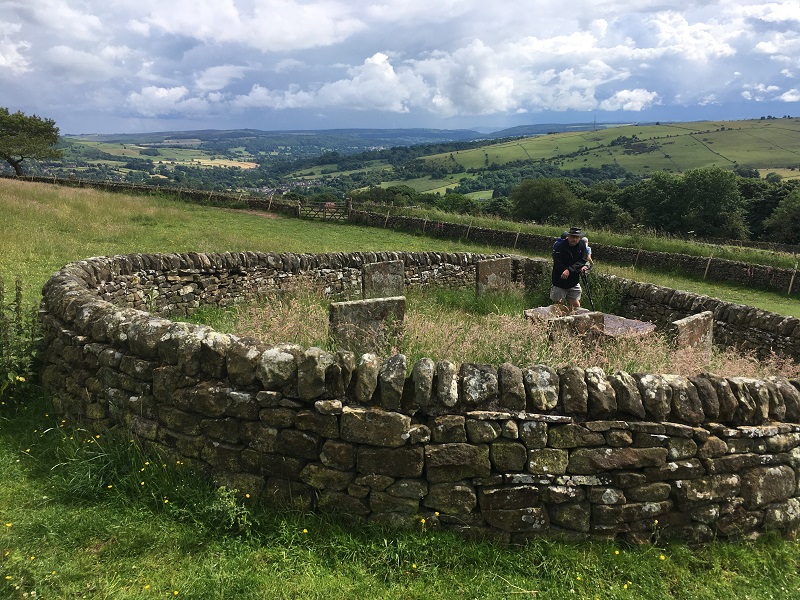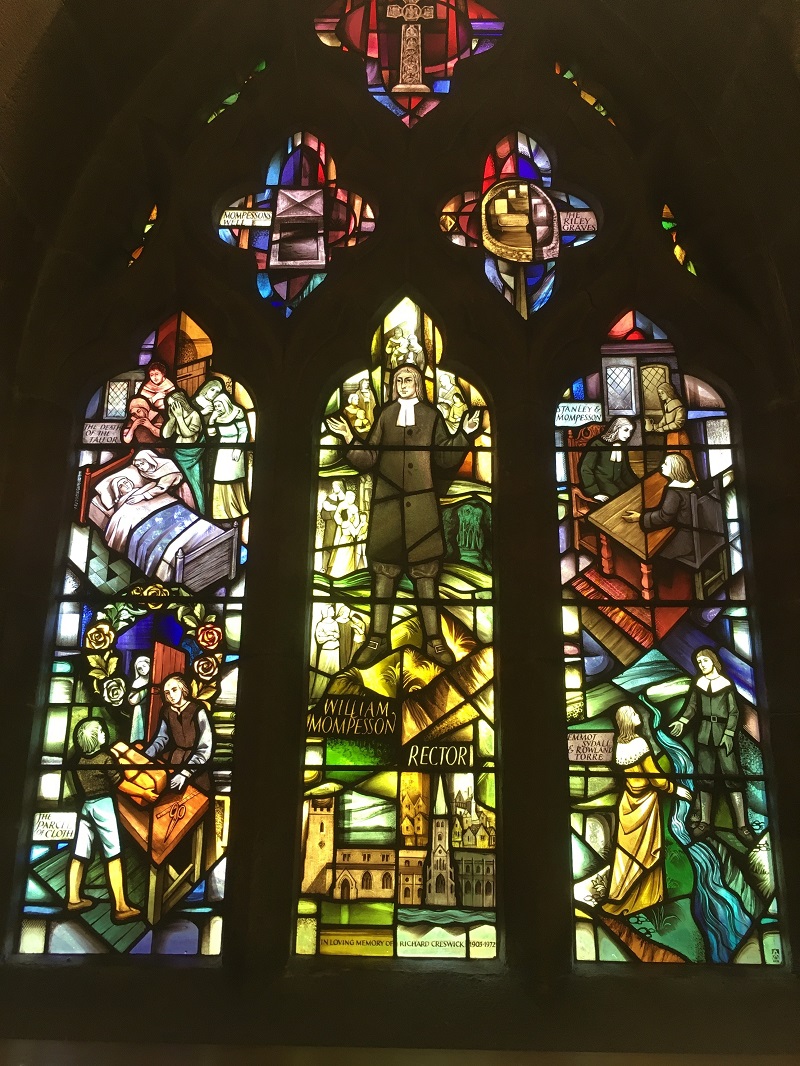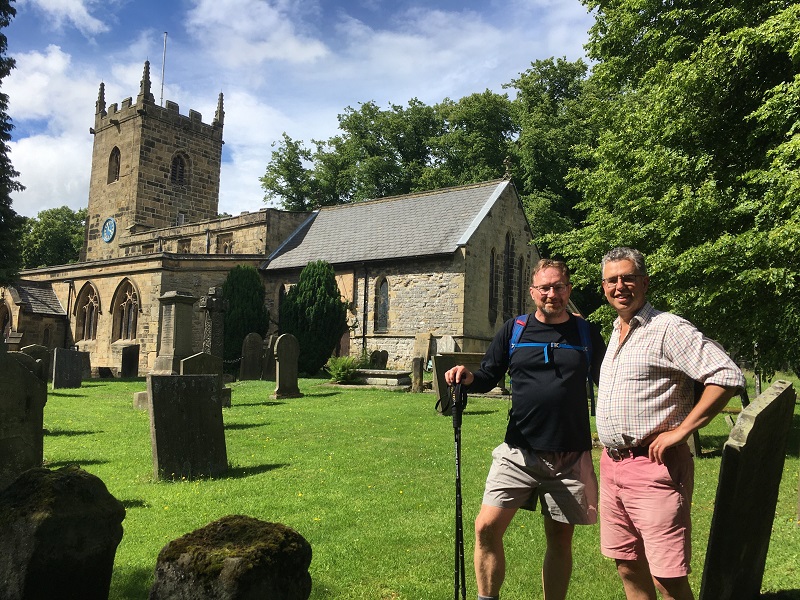Will-making in a pandemic – 1665-6 and now
We used to have a Syrian lodger. He has now taken and passed his British Citizenship test. Some British friends and I tried the practice test questions and found them surprisingly difficult! I gave him my view of what the real test of an English (as opposed to a Scottish or Welsh) person should be: can he name the two most important years in our history? You’ve guessed them: 1066, the Norman invasion, and 1966, the year England won the world cup for football. If there was to a third, my vote would be for 1666, the year of the plague and the Great Fire of London. It has the added advantage for taking a test that it is has a certain symmetry to the other dates!
1666 is generally reckoned as the year the plague came to an end.
It is also the year that put the village of Eyam in Derbyshire on the map. So much so that it was to Eyam that a group of five Chinese students came one Sunday in late 2019. They visited the church and asked the Vicar to “to pray for their country in the grip of the coronavirus epidemic. They came to us because they knew our plague story[1] and thought we would understand. We did!… The media interest in Eyam during 2020 has been incessant, our self-sacrifice story resonating afresh with new power in a covid world.”[2]
I am going to be considering Will-making in Eyam, which has become known as the plague village, in 1665-1666, and my recent experience of Will-making in Oxford in the corona virus pandemic of 2020-21.

A French author once said: “The more things change, the more they remain the same.”[3]
What has changed between 1665-6 and now? Pandemics? Nothing new. Quarantine? Nothing new. Bubbles? Churches closed for services? Grim statistics being kept? Nothing new. Panic and grim tragedy, separation from loved ones, mental health and economic challenges? Nothing new. Face masks? Nothing new. Loss of sense of smell?[4] Nothing new. Empty town centres?[5] Nothing new. The sudden need to get Wills made? Nothing new.
What has changed from 1665 to our pandemic today? The language of religion in the public sphere has all but disappeared. Vaccines have arrived. Language is more scientific now – they talked of preventing the spread of the plague ‘seed’; we talk of the virus. Social distancing has changed, but now how you might think. They said it should be 12 ft to be safe. We say 6 ft or 2m. There were however some ways of dealing with the virus which we would certainly not recognise, and I can’t quite hear Boris Johnson announcing “All should studiously avoid dancing, running, leaping about, lechery and baths.”[6]
The Eyam story
For those who have not heard the Eyam story, here it is. In September 1665, the plague arrived in Eyam via a travelling tailor and some infected cloth from London. We are going to be considering a Will made shortly after that. The plague seemed to fizzle out that winter, only to re-emerge with a vengeance the following May. That was when the momentous decisions were taken in Eyam by the two leading churchmen, William Mompession, the Rector and his predecessor Thomas Stanley the puritan, to call the whole village to quarantine, to save the Midlands of England. The whole village obeyed, moved by simple but profound words of Scripture like this one: “Greater love hath no man than this, to lay down his life for his friends.” [7] The result was that the plague was contained. There were no deaths outside the parish. But it had deadly consequences for those who stayed behind. Two-hundred and fifty men, women and children died out of a village of 750.

William Mompesson wrote of this time, “The condition of this place hath been so dreadful that I persuade myself it exceedeth all history and example. I may truly say our Town has become a Golgotha, a place of skulls… My ears never heard such doleful lamentations. My nose never smelt such noisome smells, and my eyes never beheld such ghastly spectacles.”[8]
One woman, Elizabeth Hancock, buried her first child on 3 August 1666. By 10 August, her husband and six children were all dead and she buried them all in a field outside the churchyard.[9] [10]
Mompesson himself paid a high price. Having sent their two small children away, his wife Catherine refused to leave his side. Caring for the sick and bereaved, she died on 25 August 1666 just as the peak infections were past. Mompesson was convinced he would die next and wrote a most beautiful and grief-stricken letter to his patron Sir George Savile, his executor, immediately after losing Catherine, ending in this way. “And with tears I beg that when you are praying for fatherless infants, that you will remember my two pretty babes. Sir, pardon the rude style of this paper, and if my head be discomposed you cannot wonder at mee,… your most obliged, most affectionate and gratefull servant, William Mompesson.”[11] He was just 28 years old.
So what of Will-making in a pandemic?
I had just completed doing a walk called the Peak Pilgrimage in June this year, which ends in the village of Eyam, with a fellow lawyer Stephen Schneider. One of the many historic village plaques says “Rev Thomas Stanley… He wrote Wills for a number of the victims.” That led me to contact the curator of the Eyam Museum and I am delighted to be able to share with you a transcript[12] of one of those Wills, made in a pandemic. If I may, I will read a few excerpts for you, before telling you of my experiences of Will-making in our most recent pandemic.
“IN the name of God Amen. The 11th day of October 1665. I Richard Coyle of Eyam, in the county of Derby, miner, being weak in body, but of good and perfect memory and understanding to make and ordain this my last will and testament…”
“Firstly I do give and bequeath unto Alice Coyle and Elizabeth Coyle my two daughters my mare and my cow …
“Also I bequeath and leave my cupboard and my great coffer in my house unto Anne my wife…
“I do give and bequeath unto Joan Coyle my natural mother my best suit of my wearing apparel…
“I do give and bequeath the tenant right of my cottage unto Anne my wife and Joan my mother
“Richard Coyle, signed sealed and delivered in the presence of us, Thos Stanley, John Stanley, Wm Ainsworth”
He was buried on 2 December 1665 and listed no. 38 in the plague list in Eyam church[13]. His wife Anne was buried July 1666, victim 89. His daughter Alice, age 5, was buried August 1666. His mother and other daughter Elizabeth survived the plague. An inventory was drawn up on 20.1.1666 by Thomas Stanley and others. The mare and cow were valued at £4. His most valuable assets were his ‘purse and apparell’ £5 and ‘debts owing by severall persons’ £5. The Will was proved by Wm Mompesson among others in Chesterfield on 4 April 1667.[14]

So what of Will-making in this recent pandemic? I have a different perspective from an academic historian due to my working full-time as a solicitor and partner in Blake Morgan, a law firm. Making accurate Wills which achieve my clients’ objectives is part of my profession. I immediately related to Thomas Stanley when I saw the plaque.
In the week beginning 16 March 2020, lockdown began[15] and our physical office was all but shut down. On 19 March, this message was circulated from my business group head, “For the avoidance of any doubt, I repeat that the starting position of the firm is that face-to-face meetings should not be taking place unless it is critical to do so. I recognise that this is difficult for Private Client lawyers [not least because] face-to-face meetings are a professional requirement in many cases to satisfy ourselves that the client has capacity, understands our advice and is not subject to undue influence.”[16]
I remember my very first clients after lockdown was announced. “I am a GP with an out of date Will. It has been on my to-do list for ages unactioned. Given the current coronavirus pandemic I would like to update it asap preferably consulting remotely… We have a house worth £2m…. With great thanks…”[17] The GP and her husband and her spouse had dependant children who, not unlike the Mompessons, were living separately from their parents for isolation reasons given the parent’s responsibilities in the fight against the pandemic. Draft Wills were produced to them 7 days later on 25.3.2020. I am pleased to say that they came through the pandemic and the Wills were not needed but they were hugely grateful to have a weight taken off their shoulders.
I have three comments to make about Will-making in the recent pandemic.
- Firstly, necessity is the mother of invention, and we became quite creative about how to ensure things were done properly e.g. involving tables in drive ways and a very useful case called Casson v Dade from as long ago as 1781. The witnesses were held to be ‘in the presence of’ the testatrix where they were inside the building and she was in her carriage outside because of the ‘line of sight’ test! In summary, I am not aware of anyone who wanted one who did not get a Will made in time which was not accurate and effective.
- Secondly, are you not in someone’s presence or ‘line of sight’ when you are watching on a video? Law admittedly often lags behind technology and is inherently conservative. Lawyers have enjoyed hypothesising over this, but it focuses the mind when you are being paid to deliver a validly executed Will. I am not aware of any professionals who have sanctioned video witnessing, although it may be happening. Legislation[18] has been introduced which said virtual witnessing via live video-link will be acceptable, back dated to 31 January 2020 and until 31 January 2022, provided certain conditions are met. I suggest that like Casson v Dade, these new rules are less about encouraging the practice than about giving courts the ability to come to the ‘right decision’ and save home-made Wills made in the heat of the pandemic from being struck down on a technicality. Case law of course always follows the event and it remains to be seen how widely video witnessing was done. If someone came to us with such a Will, we would always advise they be signed again at once, subject to the testator still having capacity. It will be noted this is not a permanent change in the law.
- Thirdly, I like to think that while it may not be as glamorous as the health care professionals we used to clap, or Captain Sir Tom Moore, or vaccine designers, as private client practitioners we have nevertheless played our small part in the pandemic. In Eyam church, a stained glass window commemorates the plague. Catherine Mompesson is known to have worked tirelessly visiting the sick until she too fell victim. In the window, sadly her ministry ‘in our eyes lies very much in the background … [She is depicted] as a shadowy figure moving behind Mompesson and Stanley.’ [19] Thomas Stanley himself has no marked grave anywhere, and if he is famous, it is for his joint leadership with Mompesson. And yet the leading living plague historian[20] in Eyam told me how wonderful the Wills were which he wrote because they were legible. What peace it would have given the dying to know that their affairs were in order, or to the heirs, to have the probate process conducted smoothly and lawfully! In the Coyle Will he appears to have written it, witnessed it and then after Coyle’s death, he did what we would call the probate papers. This is valuable, almost invisible, unsung work.
In the same way, in the private client team we are doing our best to serve clients through all parts of the covid cycle. First, there was the frantic Will-making against the backdrop of a fast-spreading and potentially lethal virus against which there was no vaccination. Then, there has been the flood of probate cases and trying to provide a sensitive but effective service administering estates in spite of an overwhelmed probate court system, land registry and HMRC. Following the pandemic, with the government looking for ways to reduce the budget deficit through taxation, and with rising cost of living, clients want help structuring their affairs in such a way as to minimise tax for their offspring.[21]
Time alone will tell which years are significant. Had England won the Euros last summer, that might have supported a bid for 2021 to be special. However, I already struggle to remember which was Brexit year. I guess that few of us in this room will shape history on this kind of scale. However, like Thomas Stanley or Catherine Mompesson, when a crisis comes, we all find ways of contributing our skills for the common good. In such a way, although we will not be remembered for anything like the sacrifice made by the people of Eyam, we can follow their example of laying down our lives for the good of others. While the circumstances and nature of the crisis may change, this principle remains the same.
I believe this is very much a principle lying behind Rotary, and I would like to thank you for the invitation to speak to you today.
Appendix
[1] See, for example, this Chinese website page published 30 May 2020 https://www.sohu.com/a/398707693_405849
[2] Bob Jackson, Hope Pilgrimage 2020 p. 118
[3] “Plus ca change, plus c’est la meme chose » French writer Alphonse Karr
[4] “How sweet the air smells!” This exclamation from Catherine Mompesson in August 1666, after hours of work among villagers, ‘filled Mompesson with alarm as he realised its dreadful import.’ She died a few days later. John Clifford, Eyam Plague 1665-1666, p. 26
[5] “O Lord, how empty the streets are!” Samuel Pepys diary, 6 October 1665
[6] James Leasor – The Plague and the fire
[7] John 15:13
[8] Letter to his Uncle John Bielby after the event in 1672. Original letter held by the Trustees of the Chatsworth Settlement. Quoted in R.M. Beaumont, The Reverend William Mompesson – Hero of Eyam 2012, p.2
[9] They are known as the ‘Riley graves’. The enclosure belongs to the National Trust.
[10] There are many, many such stories. Another is the touching romance of the 22 year old Emmott Sydall who lost her dad and four siblings in the first round of the plague in October 1665. She was betrothed to Rowland Torre. Each day that winter they saw each other in a special place but could not touch or speak in case Rowland should get infected. Towards the end of April 1666 she stopped coming but he continued every day until the plague was over. He then found out she had died on 29 April. Rowland never married.
[11] Letter to Sir George Savile, original held by the Trustees of the Chatsworth Settlement.
[12] By kind permission of Eyam Museum
[13] Although interesting, the curator of Eyam Museum says Coyle died of natural causes and that the date of burial was 1 December.
[14] There is a lot more I would like to investigate. The Wills were written on parchment, the original held at Lichfield in the 1990s but now moved to a storage facility in Stafford. What was the equivalent of the executor’s oath? What of Coyle’s tools of trade? What of the reference to his ‘Rake and Mine’? Where in Eyam was Coatgreen (now demolished)? How common was the redeeming of the gifts in kind, and how could Anne have afforded to pay the cost of the redemption? Parchment would not be cheap. There would have been exceptional demand. Who provided it? The Earl of Devonshire? Where were completed Wills kept? The Eyam historian thinks kept privately, like today, not at the church or anywhere else.
[15] This talk could be sub-titled ‘A tale of two Hancocks: Elizabeth Hancock, the Eyam widow, and Matt Hancock, Health Secretary during the covid pandemic.’
[16] Memo from Helen Bunker 19.3.2020 quoted with permission. The memo also quoted recommendations provided by the Society of Trust and Estate Practitioners to its members the same day. “Practitioners are therefore in a difficult position as it may not be possible to comply with the government’s guidance to reduce social contact while also arranging for wills to be validly signed.”
[17] Email sent by client to James Greig on 18 March 2020 and quoted with permission.
[18] “(2) For the purposes of paragraphs (c) and (d) of subsection (1), in relation to wills made on or after 31 January 2020 and on or before 31 January 2022, “presence” includes presence by means of videoconference or other visual transmission.” Wills Act 1837 (Electronic Communications) (Amendment) (Coronavirus) Order 2020
[19] John Clifford, Eyam Plague 1665-1666 p. 26
[20] Arguably Francine Clifford, widow of John Clifford to whom his book “Eyam Plague” is dedicated
[21] In some ways the need for help throughout the covid cycle supports what Benjamin Franklin wrote, “In this world, nothing can be said to be certain except death and taxes.”
All photos taken by James Greig on a visit to Eyam.
Enjoy That? You Might Like These:
articles
articles

